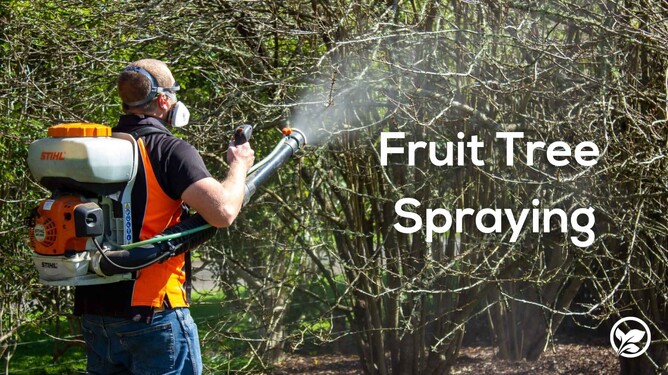Caring for your fruit trees all year long is necessary for some varieties of trees because they can be more likely to suffer from pests and diseases.
It can be caused by several factors like location, climate, the spread of diseases from neighbouring trees or, in most cases, just bad luck.
Our environment can be full of surprises, so we are here to help guide you through it. We hope that all garden enthusiasts have the right tools to take care of their green space and have their fruit trees thrive for the seasons ahead.
Before spraying, everyone should understand how diseases spread. They travel by wind or moisture and thrive in humid weather. When disposing of leaves, we suggest burning them or disposing of them somewhere safe where they won’t spread to other trees. It’s also essential to disinfect tools and equipment used to eliminate infected leaves. To avoid future diseases, keep fruit trees on the property with good airflow and prune them to increase air movement in the tree canopy.
Fruit Tree Spraying in Autumn
Autumn is the time of the year when deciduous trees reach the dormancy period with their leaves dropping. It’s the ideal time to apply a clean-up fungicide.
Copper oxychloride is a good organic for covering the fungal spores and bacteria that cause diseases like leaf curl, bacterial blast and leaf spot. However, we recommend adding a good amount of solution because the fungal infections can easily make their way through the crevices of the tree.
If a disease spreads, covering the whole tree with copper will mean less infection when the tree comes into blossom and leaf next season.
Fruit Tree Spraying in Winter
The colder season is essential since it gives you an extra chance to cover any lingering diseases or pests in your fruit trees.
Preventative spraying during winter will help prevent the disease from invading spring leaves, stems and fruit and kill overwintering insects.
In August, we suggest spraying cooper on small stonefruit trees before the buds break open because we have a lot of issues with fungi in the Waikato.
Fruit Tree Spraying in Spring
The combination of warmer and wet weather promotes rapid spore and bacteria growth, triggering early spring fruit tree infections.
Most common diseases that accelerate during spring.
- Leaf curl (in peaches and nectarines)
- Black spot (in apples and pears)
- Bacterial blast (mainly in stone fruit)
- Botrytis (mainly in berries and grapes)
The earlier you spray on your fruit trees, the better. Prevention is critical if you try to avoid these infections later during the season.
As soon as the bud breaks, cover it again with the cooper. Getting inside the bud once it opens is essential to protect the new part of the branch. In addition, this will cure leaf curls and discourage aphids and thrips.
Don’t spray when it rains. It won’t work. It’s better to spray when the sun is out for a while. Furthermore, to avoid the growth of black spots on pip fruit trees, try covering them with fungus fighter. Unfortunately, if the fruit tree is infected with the fungal black spot, you can’t treat it.
In mid-spring, we suggest respraying cooper when the stonefruit is fully bloomed to limit brown rot and other pests.
Fruit Tree Spraying in Summer
Since the weather is drier and warmer, there are fewer diseases and pests than in the previous season.
Although, brown rot disease can affect stonefruit trees even after it’s in fruit. It can affect places in the northern regions where humidity is high. You can apply copper only at a weak rate to avoid burning off the tenders growing on the tips and leaves.
We regularly offer to spray trees for our customers, so if you need help in doing so, we are more than happy to have a chat with you about the matter.
If you need to find out more about diseases and pests in New Zealand, we recommend reading our blog article on common garden diseases in New Zealand.




